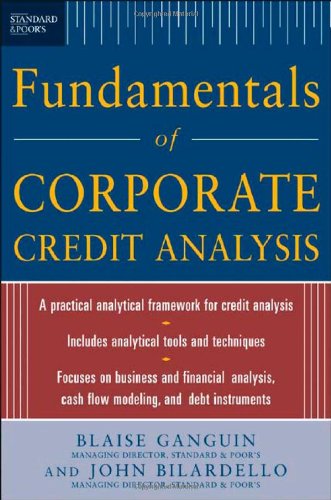Standard & Poor's Fundamentals of Corporate Credit Analysis epub
Par johnson heather le mercredi, décembre 23 2015, 22:06 - Lien permanent
Standard & Poor's Fundamentals of Corporate Credit Analysis. Blaise, Ganguin

Standard.Poor.s.Fundamentals.of.Corporate.Credit.Analysis.pdf
ISBN: 0071454586, | 463 pages | 12 Mb

Standard & Poor's Fundamentals of Corporate Credit Analysis Blaise, Ganguin
Publisher: McGraw-Hill
New York, NY – August 2, 2011 Standard & Poor's announced today that it has commenced Factual Stock Report coverage on CornerWorld Corporation (OTCBB:CWRL). The cut to the two state-run companies is in line with S&P's cut to Brazil's sovereign credit rating. Weekly with the latest pricing, trading volume, and other data, the reports include recent developments, a financial review, key operating information, Industry and peer comparisons, institutional holdings analysis, Street Consensus and opinions, performance charts, business summary, fundamental data, and news. Perhaps because I'm not an economist, I can't at all interest myself in the question of whether the US “deserved” to have its credit rating downgraded (as Standard and Poor's has done). Standard and Poor's forecasts modest growth for the rest of 2013, stating that “weaker fiscal and external fundamentals, and some loss in the credibility of economic policy given ambiguous policy signals could diminish Brazil's ability to Eletrobras is Brazil's electrical utility company and Petrobras is a multinational energy corporation headquartered in Rio de Janeiro. A simple analysis of the company's initial ratings of debt offerings compared to later ratings of the same offerings would probably show a pattern of nothing but no changes or downgrades. Although not a downgrade, it is a shock for an emerging market leader whose economic fundamentals have been improving so consistently in recent years that the upward trend was almost taken for granted. Donald Marron: S&P's 2 Trillion Dollar Error: The error is understandable but remarkably sloppy for such an important analysis. �More than two years after the beginning of the recent crisis, U.S. S&P issued credit ratings on more than $2.8 trillion of residential mortgage-backed securities and about $1.2 trillion of collateralized-debt obligations from September 2004 through October 2007, according to the complaint. Credit rating agency Standard & Poor's on Monday upgraded its credit outlook for the United States government to stable from negative, saying the chances of a downgrade of the country's rating is less than one in three. And these people are pronouncing on US credit-worthiness? Meanwhile, the Department of Justice complaint against S&P says financial institutions relied on credit ratings "to identify and compare risks" among various instruments. And only point us towards a simpler way of addressing the problem: Standard and Poor's is a self-interested corporate entity and it is acting in accordance with what it perceives its self-interest to be, in precisely the way that self-interested corporate entities will consistently do. This is also "According to Fitch Ratings (2007), around 60% of all global structured products were AAA-rated, compared to less than 1% for corporate and financial issues." How can a majority of a . Commentary and analysis from outside voices in venture capital, hedge funds and economics.
Modelling Extremal Events: for Insurance and Finance (Stochastic Modelling and Applied Probability) book
Oxford Handbook Of Tropical Medicine book
Numerical Simulation of Optical Wave Propagation With Examples in MATLAB pdf download